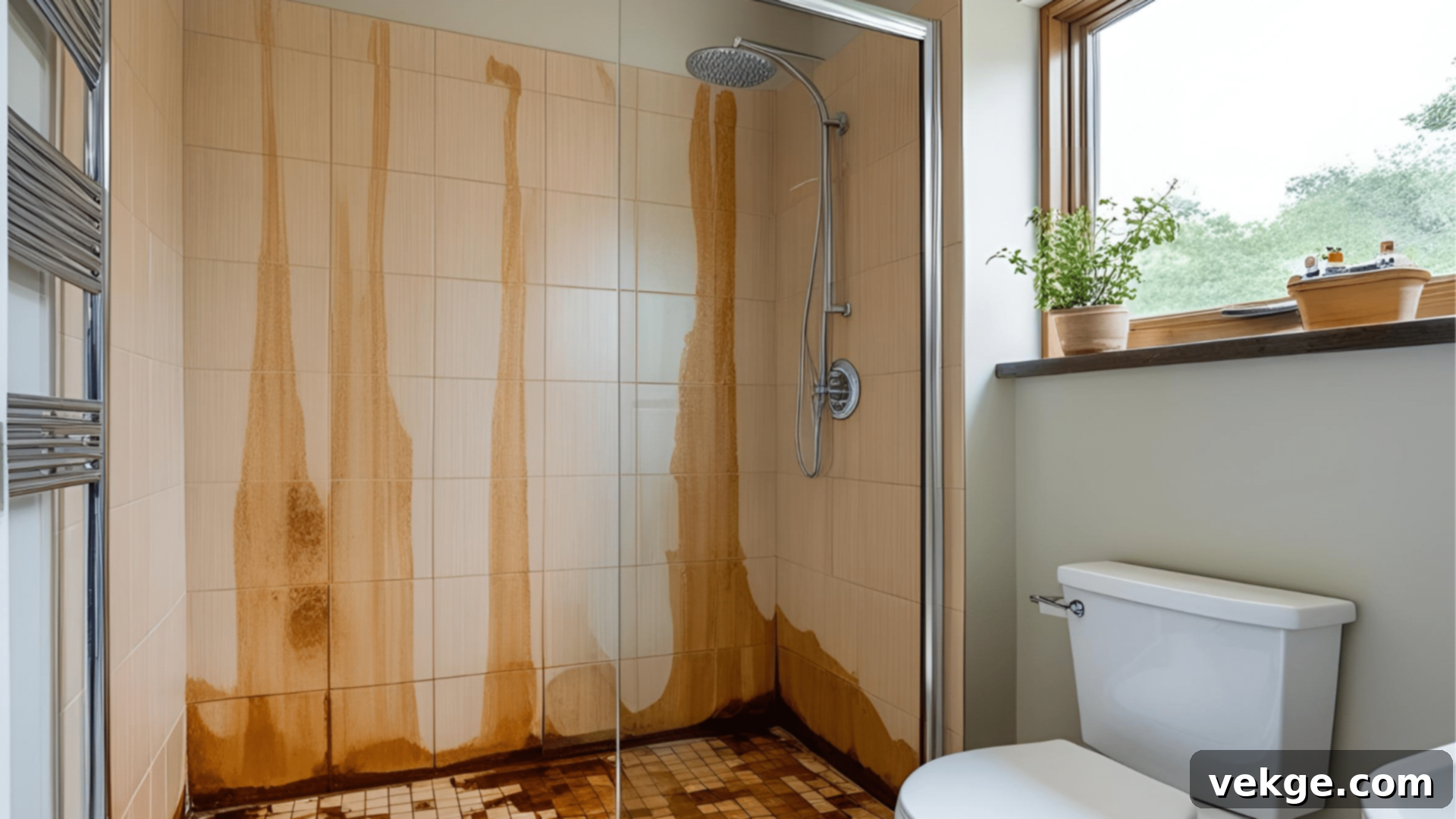The Ultimate Guide to Removing and Preventing Stubborn Orange Shower Stains
Few things are as frustrating as stepping into your shower only to be greeted by unsightly orange streaks, rings, or splotches. These common bathroom nuisances not only detract from your bathroom’s cleanliness but also raise questions about their origin and potential impact. Whether they’re clinging to your shower walls, pooling around the drain, or staining your grout, these stubborn marks typically signal one of two issues: high iron content in your water supply or the proliferation of specific bacteria in damp, warm environments.
The good news is that these orange stains are not permanent fixtures! With the right knowledge and a few effective strategies, you can banish them for good. This comprehensive guide will equip you with everything you need to know: from understanding the root causes and accurately identifying the stain type, to implementing proven removal techniques and establishing preventative measures. Get ready to reclaim a sparkling clean, fresh, and inviting shower space!
Understanding Orange Stains: What Are They and Where Do They Come From?
Orange discoloration in your shower is a widespread problem, often appearing surprisingly quickly. Pinpointing the exact source is the first step toward effective treatment. These persistent stains primarily originate from two distinct culprits: dissolved iron in your water or bacterial growth.
Iron Deposits: The Origin of Rust Stains
One of the most frequent reasons for reddish-orange shower stains is the presence of iron in your household water. Many water sources, whether from municipal systems or private wells, naturally contain varying levels of dissolved iron. While this iron is dissolved and invisible when the water first comes out of the tap, it undergoes a chemical transformation upon exposure to air and oxygen. This process, known as oxidation, is essentially the same as metal rusting.
As the iron oxidizes, it changes from its clear, soluble form into insoluble, reddish-brown particles. These particles then precipitate out of the water and deposit onto shower surfaces, creating those familiar rust-colored marks. You’ll commonly observe these streaks wherever water flows or collects, such as down shower walls, around drains, along the waterline in tubs, and on showerheads. The interaction with soaps and shampoos can also accelerate this staining, embedding the orange discoloration into porous materials like grout and certain types of tile.
Bacterial Growth: The Case of “Pink Mold” (Serratia Marcescens)
Another common cause of orange, pinkish-red, or yellowish-orange discoloration in showers is the presence of airborne bacteria called Serratia marcescens. Despite its misleading nickname “pink mold,” it is a bacterium, not a fungus. This organism thrives in warm, moist, and nutrient-rich environments – conditions that perfectly describe your shower. It feeds on fatty deposits from soap scum, shampoo residue, dead skin cells, and other organic matter.
You’ll typically find Serratia marcescens in areas that remain consistently damp and don’t dry quickly, such as in grout lines, silicone caulking, the folds of shower curtains, and corners where water tends to sit. Bathrooms with poor ventilation are particularly susceptible to its growth. While its vibrant color can be alarming, its presence is a clear indicator of persistent moisture and the accumulation of organic residues, which provide a perfect breeding ground for these microorganisms.
Identifying the Type of Stains: Iron vs. Bacterial Growth
Distinguishing between iron stains and bacterial/mold growth is critical for choosing the most effective cleaning method. Each type has distinct characteristics you can use for identification. Pay close attention to the color, location, texture, and any associated odors.
Characteristics of Iron Oxide (Rust) Stains
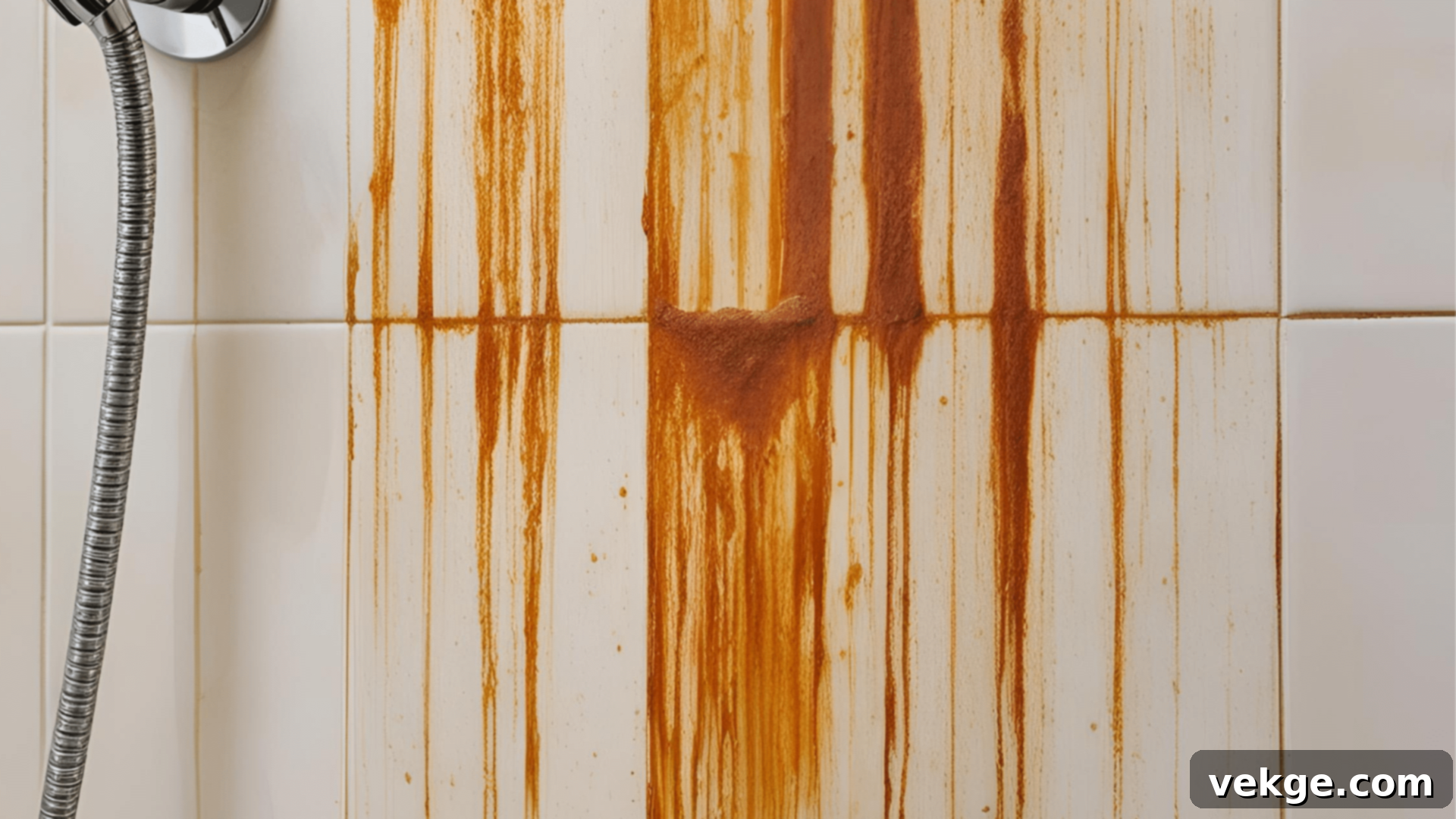
- Color: Typically a distinct reddish-orange, rust-brown, or sometimes a yellowish-brown hue. The color is often uniform within the stain.
- Location: These stains commonly follow the path of water flow, appearing as streaks down walls, rings around drains, and along the waterline in tubs or shower bases. They are most prevalent where water sits and slowly evaporates, leaving mineral deposits behind.
- Smell: Iron oxide stains are generally odorless. If there’s a smell, it’s likely from other bathroom issues.
- Texture: Can feel somewhat gritty, scaly, or powdery when dry, indicating a mineral deposit rather than a living organism.
- Reappearance Rate: Develops relatively slowly over days, weeks, or even months, gradually darkening with continued exposure to iron-rich water.
- Wipe Test: Wiping the surface might temporarily lighten the stain, but the underlying discoloration will remain and quickly reappear as new water deposits dry.
Characteristics of Mold and Mildew (Bacterial/Fungal) Stains
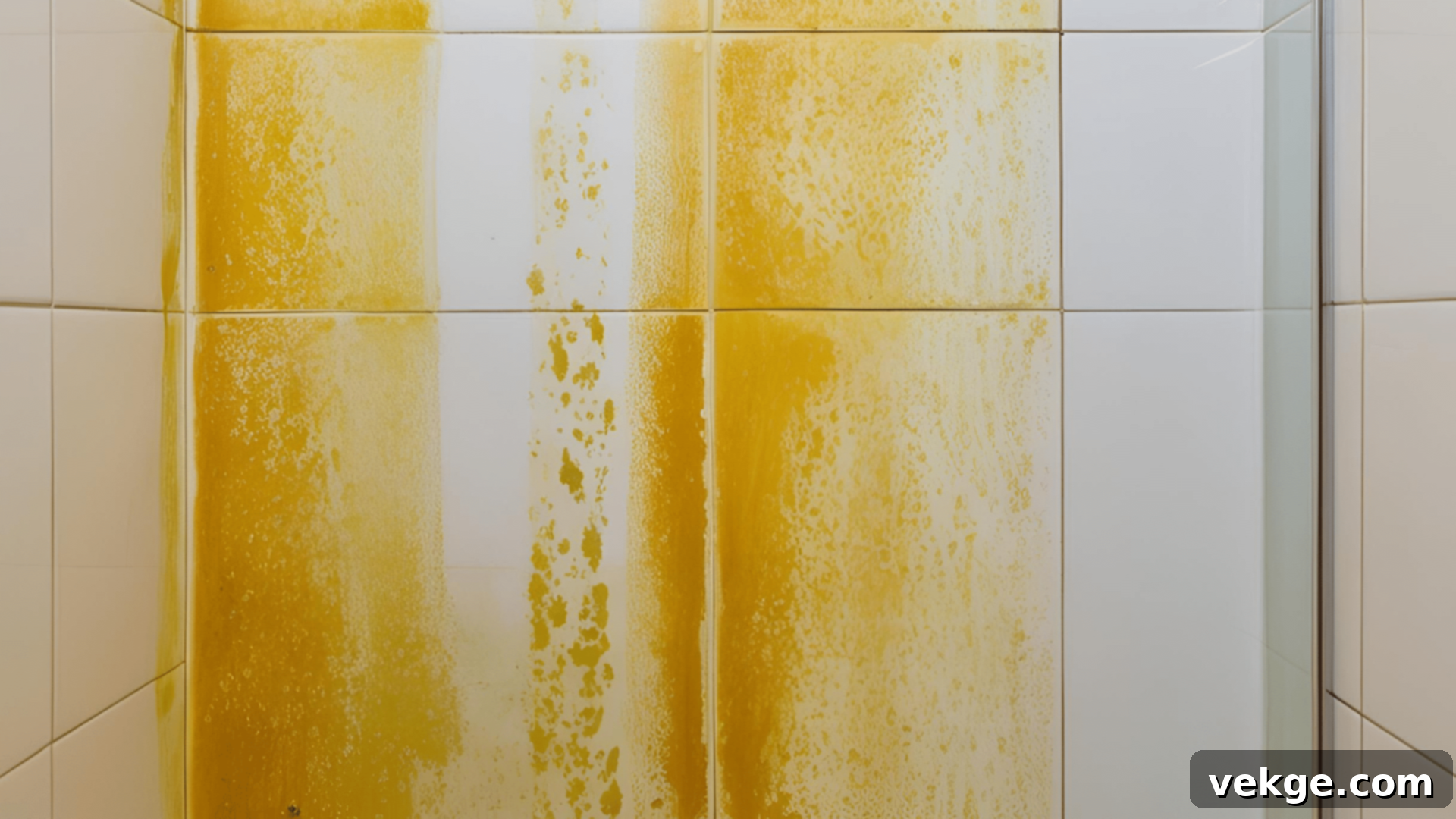
- Color: Often appears as yellowish-orange, pinkish-red, or sometimes distinct pink splotches. It can also be slimy or appear as a film.
- Location: Thrives in areas of constant moisture and poor airflow. Common sites include grout lines, silicone caulk, shower curtain folds, corners where water collects, and around faucet bases. These are typically areas where organic residue also accumulates.
- Smell: Frequently accompanied by a distinct musty, earthy, or sometimes faintly sweet odor, especially noticeable in enclosed, poorly ventilated shower spaces.
- Texture: Often feels slimy, greasy, or sometimes slightly fuzzy to the touch, characteristic of bacterial or fungal growth.
- Reappearance Rate: Can reappear relatively quickly (within days or a week) after cleaning if the underlying moisture and food sources are not addressed.
- Wipe Test: Wiping the surface will often smear the bacteria or temporarily remove it, but it will rapidly regrow if the environment remains favorable.
Is There a Health Concern with Orange Shower Stains?
The potential health risks associated with orange shower stains vary significantly depending on their underlying cause. It’s important to understand these distinctions to appropriately assess any danger and prioritize your cleaning and prevention strategies.
Iron Oxide Stains: More Aesthetic Than Hazardous
When dealing with orange stains caused by iron oxidation (rust), the good news is that they are generally considered harmless to your health. While visually unappealing and indicative of hard water, the iron particles themselves are inert and non-toxic in this form. You can safely use a shower with rust stains without fear of getting sick, experiencing skin irritations, or having your bathing water contaminated. Even if your water supply has elevated iron content, it is typically safe for both drinking and bathing. The primary concern with iron stains is aesthetic; they make your bathroom appear dirty and neglected, and if left untreated, they can become increasingly difficult to remove over time, potentially impacting the longevity of your fixtures.
Mold and Mildew Stains: A Potential Health Risk
In contrast, orange, pinkish, or yellowish stains caused by mold, mildew, or bacteria like Serratia marcescens can indeed pose health concerns, especially for certain individuals. While Serratia marcescens is often opportunistic and less virulent for healthy people, prolonged exposure to any mold or bacteria in a damp environment can lead to various issues:
- Respiratory Problems: Mold spores, when inhaled, are common allergens that can trigger allergic reactions, asthma attacks, coughing, sneezing, and nasal congestion. Individuals with pre-existing respiratory conditions are particularly vulnerable.
- Skin Irritation: Direct contact with certain types of mold or bacteria can sometimes cause skin rashes, irritation, or other dermatological reactions in sensitive individuals.
- Infections: While rare in a typical bathroom setting, significant exposure to bacteria like Serratia marcescens (especially in individuals with compromised immune systems) can, in severe cases, lead to more serious infections.
- Unpleasant Odors: The distinct musty or earthy smell often associated with mold and mildew can contribute to poor indoor air quality and an unwelcoming home environment.
Given these potential health implications, it is crucial to address mold and bacterial stains promptly and thoroughly to protect the health and well-being of everyone in your household.
Effective Strategies: How to Remove Orange Stains from Your Shower
Once you’ve identified the type of orange stain in your shower, you can select the most appropriate and effective cleaning method. Always begin with the gentlest options and escalate to stronger cleaners only if necessary. Remember, fresh stains are significantly easier to remove than old, deeply set ones. Before you start, ensure excellent ventilation in your bathroom and wear appropriate personal protective equipment, such as gloves and eye protection.
1. Natural Citric Acid Solutions (Excellent for Iron & Mild Mold/Mildew)
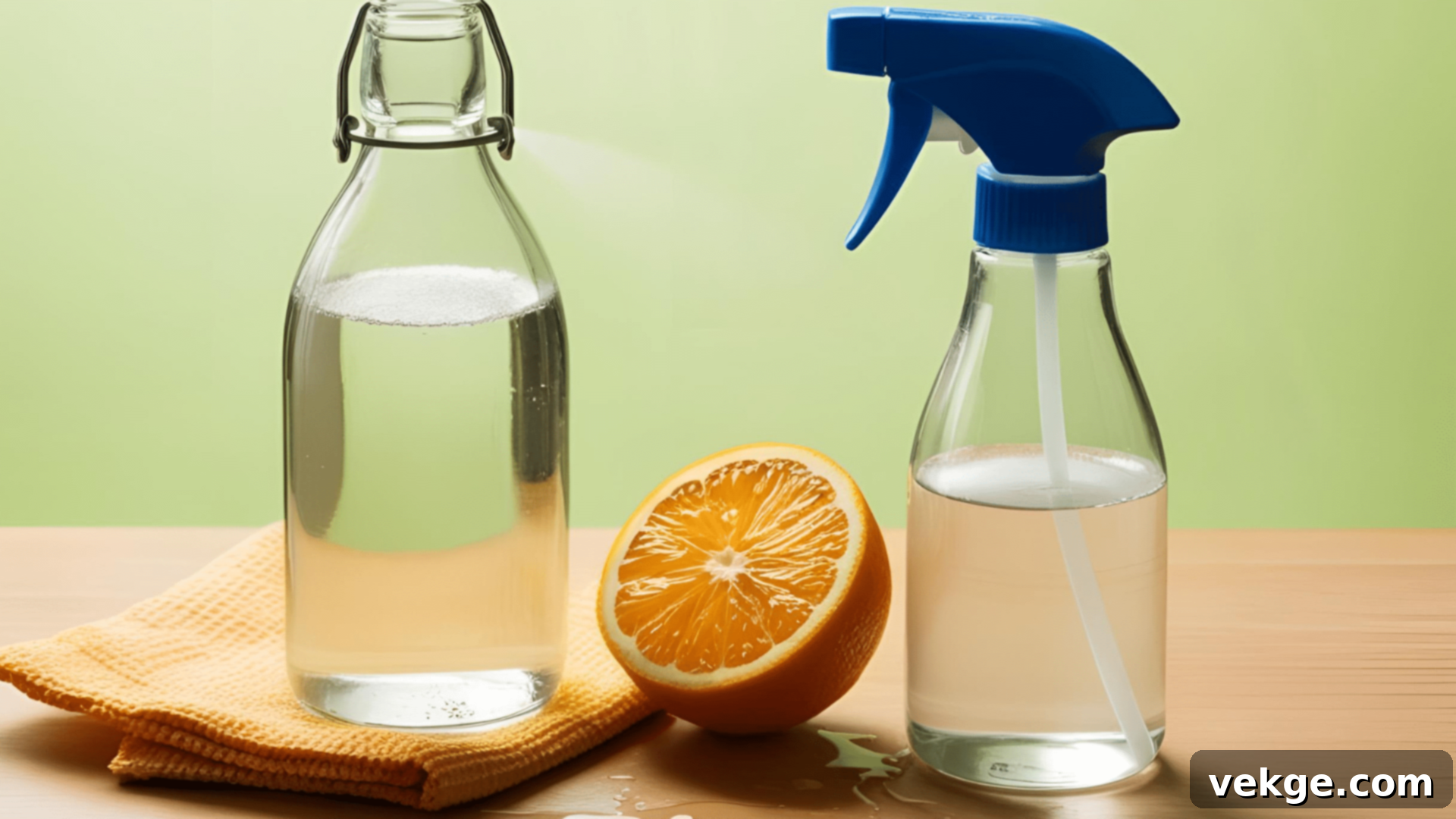
The acidic nature of white vinegar and lemon juice makes them powerful natural agents for dissolving mineral deposits like iron oxide and helping to break down bacterial films. They are safe for most surfaces and an eco-friendly cleaning choice.
- White Vinegar Method: For general stains, mix equal parts white vinegar and water in a spray bottle. For tougher iron stains, use undiluted white vinegar. Spray the solution generously onto the stained areas, ensuring complete saturation. Allow it to sit for at least 15-30 minutes, giving the acid time to penetrate and loosen the deposits.
- Lemon Juice Method: For a more targeted application, cut a fresh lemon in half and rub it directly onto the stain, squeezing gently to release the juice. Alternatively, pure lemon juice can be applied with a cloth or spray bottle. Lemon also imparts a pleasant, fresh scent.
After the recommended dwelling time, vigorously scrub the stained surfaces with a stiff-bristled brush or a non-scratch scrub pad. The mechanical action, combined with the acid, will help lift the loosened stains. Rinse the entire area thoroughly with clean, warm water to wash away all residue. Repeat the process for deeply ingrained stains, applying the solution and allowing a longer soak time if needed.
2. Baking Soda Paste (Ideal for Iron, Hard Water, & General Grime)
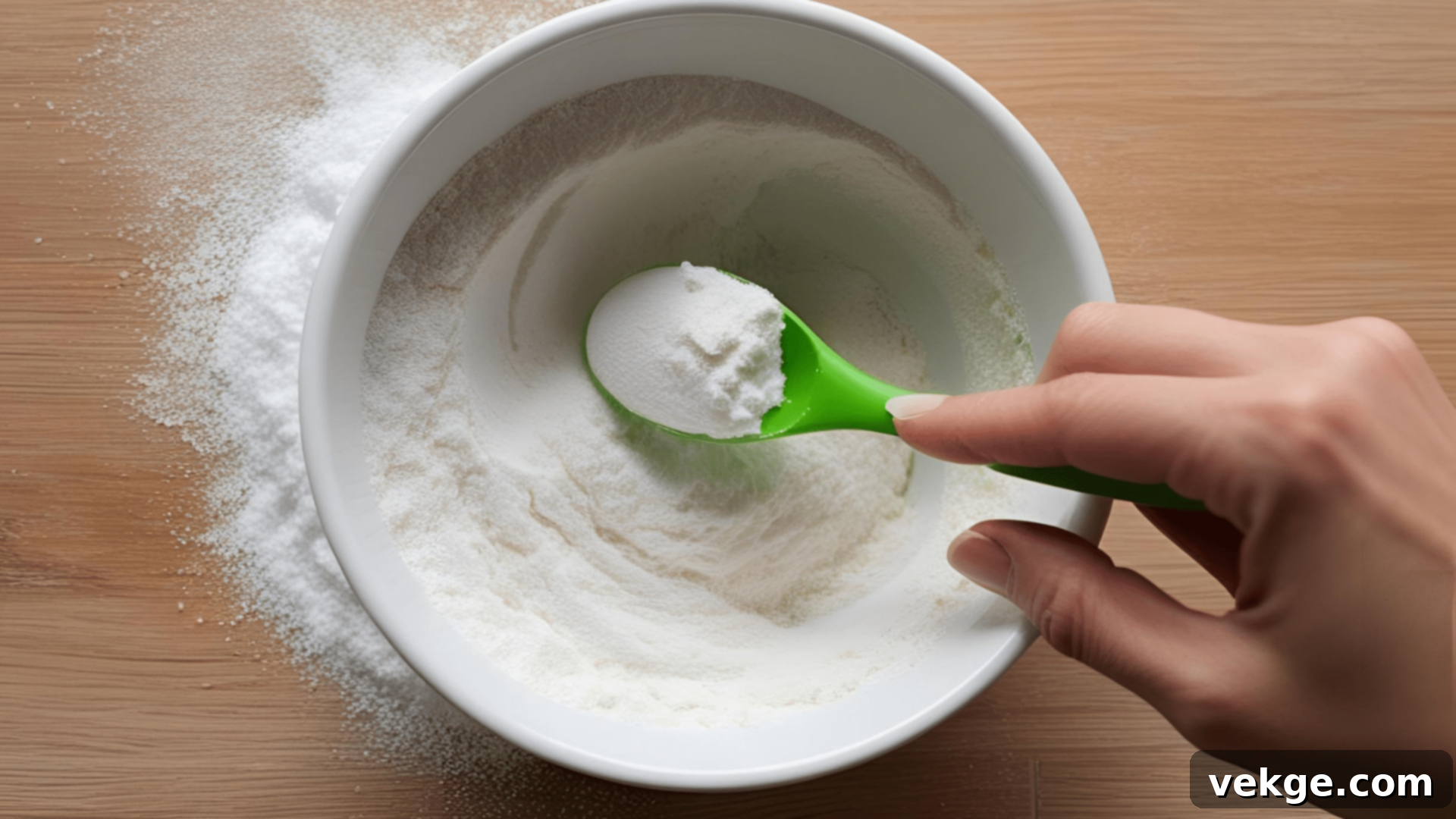
Baking soda (sodium bicarbonate) is a remarkably versatile, mild abrasive that effectively scrubs away stains without scratching most shower surfaces. It’s particularly effective against iron stains, hard water deposits, and the soap scum that often harbors bacteria.
- Preparation: In a small bowl, combine baking soda with just enough water to create a thick, spreadable paste. Aim for a consistency similar to toothpaste.
- Application: Using your gloved fingers, a spoon, or a sponge, apply the paste directly and liberally to all stained areas. Ensure the stain is completely covered with a generous layer of paste.
- Dwell Time: Allow the baking soda paste to sit on the stains for 30 minutes to an hour. For very stubborn or old stains, you can extend the dwelling time, even leaving it overnight, though ensure the paste doesn’t dry out completely by misting with water occasionally.
- Scrubbing & Rinsing: After the paste has had time to work, take a non-metallic brush or sponge and gently scrub the area using circular motions. The fine abrasive particles in the baking soda will help lift and break down the stains. Rinse thoroughly with clean water, ensuring all baking soda residue is completely washed away. A second application and scrub may be necessary for heavily embedded stains.
3. Commercial Bathroom Cleaners (For Tougher Stains & Specific Issues)

When natural remedies don’t quite deliver the desired results, commercial cleaning products offer a more potent solution. Look for cleaners specifically formulated to tackle rust, iron stains, hard water deposits, or mold and mildew. Always read and strictly adhere to the manufacturer’s instructions, paying close attention to recommended surfaces and all safety precautions.
- Product Selection: Choose a cleaner that is appropriate for your shower’s specific material (e.g., ceramic tile, fiberglass, acrylic, natural stone). Many products clearly state if they are “rust removers,” “hard water stain removers,” or “mold & mildew removers.” Avoid highly abrasive cleaners on delicate or easily scratched surfaces.
- Application & Safety: Ensure your bathroom is exceptionally well-ventilated by opening windows and running the exhaust fan. Always wear protective gloves and, if recommended, eye protection. Apply the cleaner directly to the stained areas according to the product’s directions.
- Dwell Time & Scrubbing: Allow the product to sit for the recommended duration (usually 5-15 minutes). It’s crucial not to let it dry on the surface, as this can make it harder to remove or even damage the finish. Use a non-abrasive sponge or brush to scrub the stains as directed.
- Rinsing: Rinse the area completely and thoroughly with clean water to remove all chemical residue. Incomplete rinsing can leave behind new residues, streaks, or potentially damage surfaces over time.
4. Bleach-Based Cleaners (Highly Effective for Mold & Mildew)
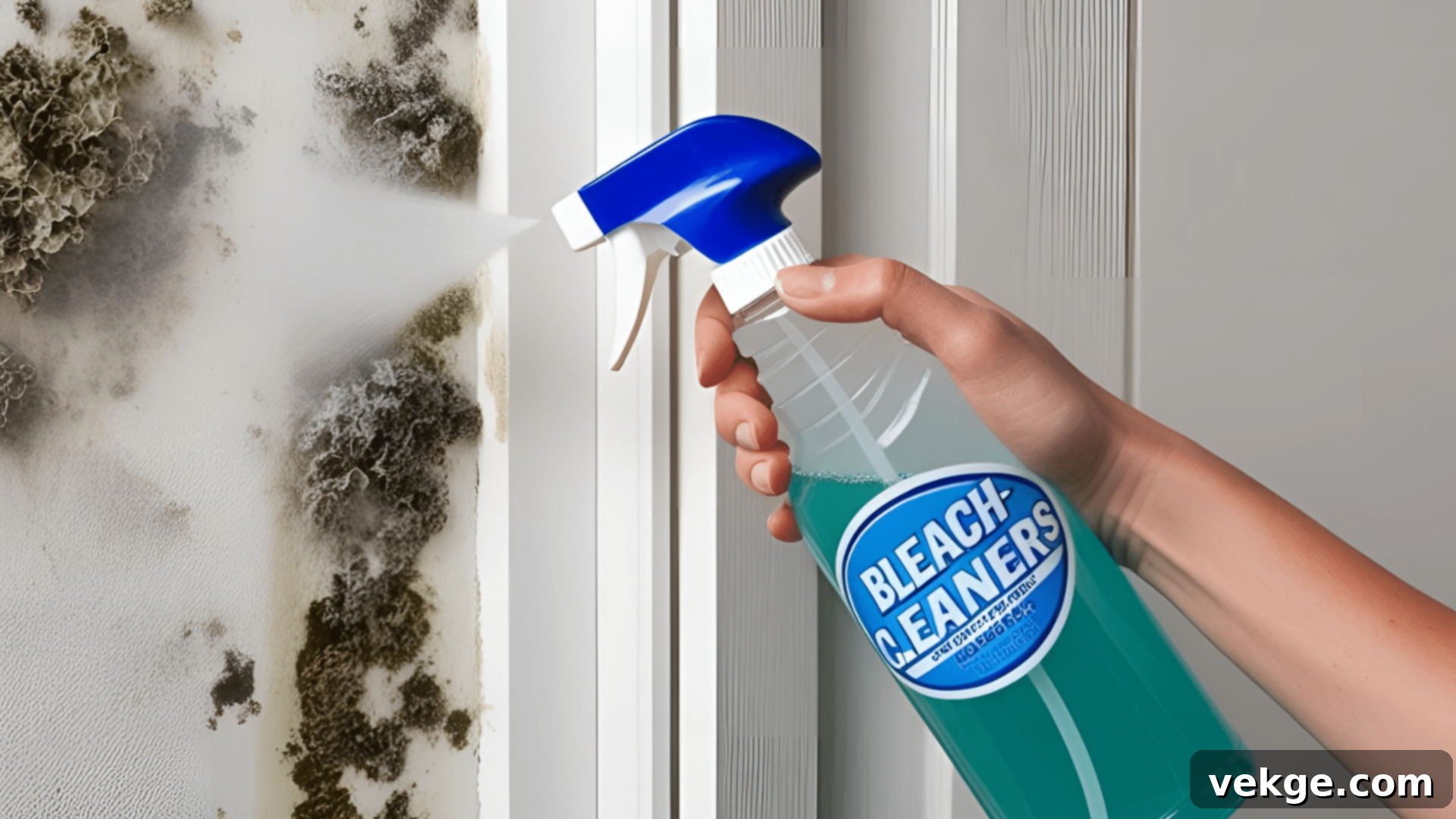
Bleach is an exceptionally powerful disinfectant and whitening agent, making it highly effective for killing and removing mold, mildew, and bacterial stains like those caused by Serratia marcescens. However, its strong chemical properties demand careful handling.
- Dilution (Crucial!): For most applications, mix one part household liquid bleach with four parts water in a spray bottle. Never use bleach undiluted unless specifically instructed by a product designed for direct application. More importantly, NEVER mix bleach with other cleaning agents, especially those containing ammonia (e.g., many window cleaners, all-purpose cleaners), as this combination creates highly toxic and potentially lethal fumes.
- Ventilation & Protection: Maximize ventilation by opening all windows and running exhaust fans at full power. Wear heavy-duty protective gloves and eye protection. Consider wearing old clothes, as bleach can permanently stain fabrics.
- Application: Spray the diluted bleach solution directly onto the mold or mildew stains, ensuring good coverage.
- Dwell Time & Scrubbing: Let the solution sit for 5-10 minutes. Do not allow it to dry on the surface. The bleach will work to kill the organisms and effectively whiten the stain. Gently scrub the area with a non-metallic brush or sponge.
- Rinsing: Rinse the area thoroughly and completely with clean water. Ensure the bathroom remains exceptionally well-ventilated for a significant period after cleaning to dissipate any remaining fumes.
Preventing Orange Stains: Keep Your Shower Sparkling Clean Long-Term
While successfully removing existing orange stains provides immediate gratification, the ultimate goal is to prevent their recurrence. Proactive measures are significantly less strenuous than deep cleaning and contribute to a consistently cleaner, healthier, and more enjoyable shower environment. The cornerstone of effective prevention lies in diligent moisture management and, where necessary, addressing your home’s water quality.
1. Daily and Weekly Regular Maintenance Habits
Simple, consistent habits can dramatically reduce the likelihood of orange stains forming in your shower:
- Wipe Down After Each Use: Dedicate just 30-60 seconds after every shower to wipe down shower walls, doors, and fixtures with a squeegee, microfiber cloth, or a clean towel. This removes standing water, which is the primary catalyst for both iron oxidation and bacterial growth.
- Ensure Proper Ventilation: Always turn on your bathroom exhaust fan during showers and leave it running for at least 15-30 minutes afterward. If you lack an exhaust fan, open a window or leave the bathroom door ajar to allow moisture to escape and air to circulate. Reducing humidity is absolutely critical for inhibiting mold and bacterial growth.
- Spread Shower Curtains Fully: If you use a shower curtain, always extend it fully after showering. This allows the entire surface to air dry completely, preventing moisture from getting trapped in folds where mold and mildew love to thrive.
- Weekly Light Cleaning: Incorporate a quick, light scrub with a mild bathroom cleaner into your weekly routine. This addresses any nascent stains or soap scum before they have a chance to set in and become major problems. Pay particular attention to grout lines, corners, and areas around the drain.
- Dry Accessories: Avoid leaving wet sponges, loofahs, or washcloths sitting in shower corners. Hang them to dry completely outside the shower or in a well-ventilated spot.
2. Addressing Water Quality with Treatment Options
If you are diligent with cleaning and ventilation but orange stains (especially the rust-colored variety) persistently return, your home’s water supply is likely the primary culprit. Investing in water treatment solutions can provide a long-term, systemic solution.
- Water Testing is Key: The crucial first step is to confirm the composition of your water. Many local plumbing companies offer free water testing services, or you can purchase inexpensive DIY water test kits from home improvement stores. These tests will reveal the precise levels of iron, manganese, hardness minerals, and other contaminants in your water.
- Whole-House Water Softener: If your water test results indicate high levels of hard minerals, including dissolved iron, a whole-house water softener can be an excellent investment. These systems work by removing mineral ions from your entire water supply before they reach your fixtures, effectively preventing both orange iron stains and general hard water buildup throughout your home.
- Dedicated Iron Filter: For homes that have specifically high iron content but otherwise relatively soft water, a dedicated iron filter might be a more targeted and cost-effective solution than a full water softener. These systems are specifically designed to remove iron particles, preventing rust stains without altering the overall hardness of your water.
- Shower Head Filters: While not as comprehensive as whole-house systems, certain specialized shower head filters are designed to reduce chlorine and some mineral deposits. This can offer a localized solution for reducing stains specifically in the shower area, though it won’t address the issue throughout your entire home’s plumbing.
While water treatment systems represent an upfront investment, they can save you significant money in the long run by protecting your plumbing fixtures, extending the life of appliances, reducing the need for harsh cleaning chemicals, and dramatically cutting down on cleaning time.
Common Mistakes to Avoid When Tackling Shower Stains
When attempting to remove orange shower stains, it’s easy to fall into common traps that can worsen the problem, damage your surfaces, or even pose health risks. Being aware of these pitfalls can save you considerable time, effort, and potential repair costs:
- Using Abrasive Scrubbing Tools: Harsh tools like steel wool, aggressive scouring pads, or stiff wire brushes can permanently scratch delicate shower surfaces such as acrylic, fiberglass, and even some ceramic tiles. Scratched surfaces become rough, making them more prone to trapping dirt, soap scum, and bacteria, which will only accelerate future staining. Always opt for non-scratch pads, microfiber cloths, or soft-bristled brushes.
- Ignoring the Root Cause: Simply scrubbing away visible stains without addressing the underlying issue (e.g., high iron in water, chronic poor ventilation leading to mold) ensures a quick and frustrating return of the problem. This leads to a never-ending cycle of cleaning.
- Mixing Cleaning Products Incorrectly: This is a critical safety concern. Never mix different cleaning chemicals, especially bleach with ammonia-based products, as this combination produces highly toxic and dangerous fumes that can cause serious respiratory damage or even be lethal. Always read product labels for warnings and follow instructions precisely.
- Neglecting Proper Ventilation: Skipping the exhaust fan or failing to open a window after showers creates a humid, warm, and stagnant environment that is the perfect breeding ground for mold and bacteria. Consistent and adequate ventilation is paramount for keeping shower surfaces dry.
- Letting Cleaners Dry on Surfaces: Many commercial cleaners, and even some natural acidic solutions, are designed to work while wet. Allowing them to dry can leave behind unsightly residues, create new stains, or even etch or damage certain finishes. Always follow recommended dwell times and rinse thoroughly.
- Waiting Too Long Between Cleanings: Fresh stains are invariably easier to remove than old, deeply set ones. Regular, even light, cleaning prevents stains from becoming entrenched and minimizes the need for aggressive cleaning sessions.
- Not Testing Water Quality: Assuming the cause of rust-colored stains without actually testing your water can lead to ineffective cleaning methods and wasted effort. A simple water test provides definitive answers about mineral content, guiding you to the correct preventative solutions.
Conclusion: Reclaim Your Pristine Shower Space
Orange stains in your shower don’t have to be a persistent source of irritation and embarrassment. By understanding their distinct origins – whether from the oxidation of iron in your household water or the growth of resilient bacteria like Serratia marcescens – you are empowered to choose the most effective and safe removal strategy.
From the gentle, dissolving power of natural acids like vinegar and lemon juice, to the effective abrasive action of baking soda, or the targeted strength of commercial and bleach-based cleaners, there is a proven solution for every type and severity of stain. Beyond mere cleaning, the key to long-term success lies in diligent prevention: embrace daily drying habits, ensure thorough ventilation, and consider investing in water treatment solutions if your water quality is the underlying issue.
By avoiding common cleaning mistakes and committing to a consistent maintenance routine, you can confidently eliminate those unsightly orange marks and enjoy a cleaner, healthier, and more inviting shower space. Say goodbye to orange and hello to sparkling clean and peace of mind!
